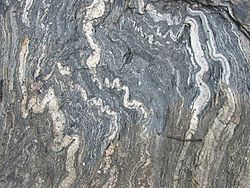Kindergarten: Off the pacing map, but what could be more appropriate than Weather! Does weather affect our daily lives? Hmmm… Also, turn it into a measuring activity as the day goes on. More snow should fall today and even tomorrow, so go stick a ruler out there, or alternative units. Better yet, measure it a few units at once. Or throw it out as a design challenge: how should we measure how much snow has fallen? You could do the same with a snowball, but in reverse. Make a big snowball, bring it inside, maybe in a bowl or bucket, stick a ruler in it, and chart its melting. You could compare the melting rates of compacted snow vs. uncompacted. Get two bowls, one with light scooped snow, and the other stuffed with snow. I’m always looking for ways to introduce measurement / graphing, and they’ll certainly be interested in how much snow is falling outside…
1st: We got a great result with our “light painting” idea. This was a basketball bouncing, with an LED taped to it. It took a few tries, but we felt that the kids understood the motion of the ball in a new way after this visualization. We’d also like to test swinging the light on a string for back and forth, and maybe taping it to a football for a zigzag patten.
3rd: This week, let’s take this indicator: “Show that objects at rest will not move unless a force is applied to them.” This is intuitive, and not that exciting by itself. Let me tell you what gets my blood pumping about Newtonian physics: that a body in motion will stay in motion until acted on by another force. Same exact principal as being at rest, but this one is counter intuitive. Why? Because there is a lot of friction here on Earth, so everything we see will slow down, once the force disappears. Stop pedaling your bike, and eventually you’ll fall over. So we want to find something with super low friction, that will keep moving long after the force has stopped pushing. The best thing I’ve found so far: a bowling ball. I bought one at the DI for $3, and if you give it a gentle push, it’ll roll about 60 feet down the hall. It’s weird – it just keeps going. This is because it has a lot of mass, and a very low rolling resistance. Thus very low friction. So kids can start to understand that if there was NO friction, it would keep on rolling forever. Unless another force comes along. Now we can start to appreciate why objects being at rest is so interesting. Let me know when I can show up to your class with my bowling ball – it’ll take just 15 minutes.
4th: Fossils. Lots of great stuff here, and you probably have your own lessons that you love. Random big idea: the shallow ocean that used to cover Utah hundreds of millions of years ago was not Lake Bonneville. Bonneville was more in the 15,000 – 30,000 year ago range, which sounds like a long time ago. But it isn’t, geologically speaking. If the Earth’s existence was a timeline 100 feet long, the ancient ocean stuff happened about 8 feet from today. Bonneville would be a fraction of an inch from the end. Trilobites did not come from Lake Bonneville. Check out think link for a little more info:
http://geology.utah.gov/popular/general-geology/geologic-history/utah-a-geologic-history/
I do the “toilet paper timeline” with 5th grade, but consider doing a condensed version of that in 4th to help them understand the timescales of fossils, the rock cycle, and weathering and erosion.
http://www.nthelp.com/eer/HOAtimetp.html
5th: I dare someone to make circuits from play doh. It totally works.
This is a “squishy circuit” and many folks are using home-made play doh, but commercial works too. Use a 9v battery, because the play doh has a much higher resistance (which is to say it’s not as good a conductor) compared to copper wire. Usually, a 9v battery will smoke any little lightbulbs / LEDs you’ve got, but with the play doh it works great. See this TED talk:
https://www.ted.com/talks/annmarie_thomas_squishy_circuits?language=en
If you need LEDs, get in touch.
6th: We’re approaching the Solstice – December 22nd. Look at a data table, such as this one:
http://www.timeanddate.com/sun/usa/salt-lake-city
See what the kids notice about the times of the sunrise / sunset. Also the length of day. The sun actually continues to rise a little later in the morning, but you can clearly see the length of day as the shortest on the Solstice. They can also notice that those sunset/sunrise times continue to change by about 1 minute (a little less) per day. Interesting patterns.
Here is a very cool video from the Exploratorium in San Francisco. The guy set up a camera on the roof, and took a time-lapse video every day for a year. Then he put all 365 vids together into one video, and synched up the times. What a cool way too use technology to observe something that’s otherwise subtle and hard to visualize. You can get the idea from the first minute or so, then skip to about 3:30 to see it all in reverse. Notice the weather variations throughout the year from the cloud cover.
https://www.youtube.com/watch?v=PNln_me-XjI
Enjoy the holiday! If anyone tells you that physicists have calculated that Santa cannot exist because he’d have to travel so fast he’d burn up in the atmosphere, tell them he obviously has an ion shield. More here: http://phys.org/news/2004-12-physics-santa-claus.html




